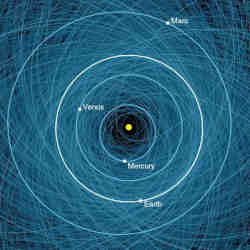
The question is not whether an asteroid big enough to cause global disaster will strike Earth. but when.
Asteroids are considered hazardous when they have a diameter of at least a few meters; a kilometer-size asteroid could cause global disaster. The U.S. National Aeronautics and Space Administration (NASA) and the European Space Agency (ESA) are keeping their eyes on as many potential impactors as possible. So far, the chance of an impact this century has been deemed very small, but a neural network trained to detect potential impactors found several that NASA and ESA appear to have overlooked.
The system, called HOI (Hazardous Object Identifier), uses a new method to identify these objects, as explained in an article accepted for publication in Astronomy & Astrophysics.
The conventional method is to scan the sky and determine the orbits around the Sun of as many asteroids and comets as possible. Once an orbit is known with sufficient accuracy, the laws of gravity allow the prediction of where that object will be up to several hundred years in the future. If its position coincides (within the margin of error) with that of the Earth at some future point, the object might be considered a potential Earth impactor.
HOI doesn't start simply with observed asteroids, but virtually fast-forwards the entire solar system 20,000 years. Next, HOI puts the solar system in reverse, with the Earth travelling back in time from 22,018 AD, all the while launching objects from its surface; 330,000 in total. Because the laws of gravity are invariant to time reversal, the orbits of objects launched from Earth at time X and travelling back in time are following exactly the same paths as objects travelling forward in time and impacting earth at time X.
It was "a Sunday afternoon brainwave" to reverse-engineer the orbits of future earth impactors in this way, says Simon Portegies Zwart, a professor of computational astrophysics at Leiden University in the Netherlands, where he specializes in large-scale computing for astronomical purposes. He explains, "The objects are launched from Earth in directions that are known from the large number of real, small meteorites that were radar-detected before entering the atmosphere."
This fast-forwarding and reversing of the solar system involves numerically integrating the gravitational interaction of the Sun, the Earth, and all the other planets over 20,000 years, a calculation that took about a week on Leiden's ALICE supercomputer.
Next, the virtual population of 330,000 objects that are known to have impacted Earth became part of the dataset for use in training a neural network. The rest of the dataset consisted of a random sample of real asteroids and comets from NASA's DASTCOM5 database. Excluded from this random sample were Potential Hazardous Objects (PHOs), objects for which it has already been calculated that they will make a close flyby – or worse – of Earth sometime in the future.
The input layer of the neural network has only five nodes, because the orbit of an asteroid is fully characterized by just five orbital parameters. Two hidden layers of seven and three nodes process the data, while the output layer is a single node with output 1 or 0, classifying the object as a Potential Impactor (PI) or not.
Training such a network just once does not involve a huge amount of computation, but optimizing the structure of the network itself took quite a bit of experimentation. This part of the project was done using the Azure cloud computing service.
With HOI's neural network configuration settled and trained, its ability to identify hazardous objects could now be put to the test on a simple laptop.
In a fresh random sample from the Dastcom5 database containing PHOs as well as non-hazardous objects, HOI correctly identified 91% of PHOs as potential Earth impactors. Further testing revealed that HOI correctly identified all objects that will come within 1.5 million kilometers (932 million miles) of Earth, about four times the distance to the Moon, in the next 1,000 years.
Even more interesting was that HOI found 11 hazardous asteroids big enough to cause regional devastation which had not been classified as PHOs in the NASA database. Fast-forwarding the solar system and these asteroids' orbits a millennium into the future revealed that they will come within a few Moon distances of the Earth in the next centuries (the first is due to arrive in December 2131). Considering the inevitable margin of error, these 11 asteroids must be considered potential Earth impactors. NASA did not find these PHOs before because the computational cost of fast-forwarding an object to determine if it is a PHO is quite large, so NASA has only done it for a subset of the more than 700,000 objects in the DASTCOM5 database.
This method of reverse-engineering the orbits of objects in the solar system over 20,000 years and then letting a neural network classify them is new and still controversial.
Ramon Brasser, an expert on solar system dynamics at Japan's Earth-Life Science Institute (ELSI), has serious doubts about the method. "In theory, one can compute the law of gravity back into the past, but this does not always work in practice." Brasser argues the solar system is chaotic over the long run, so the position of planets and asteroids cannot be predicted accurately. The path of a potential Earth impactor is particularly erratic, because it frequently crosses the orbits of inner planets Mars, Venus and Mercury, whose gravitational attractions disturb its orbit, but at what time scale this would invalidate HOI's results is not easy to decide. Says Brasser, "This method might work, but I think it would have been better to limit it to 1,000 years."
Portegies Zwart points out that the solar system is chaotic on a time scale of millions of years, not 20,000 years. The fact that HOI was able to correctly identify 91% of hazardous objects that NASA found with the conventional method proves to him that chaotic disturbance is not a serious issue in this case. At the very least, the system could be used for a quick scan of newly discovered asteroids, because hazard assessment of an orbit by HOI only takes a fraction of a second.
Arnout Jaspers is a freelance science writer based in Leiden, the Netherlands.



Join the Discussion (0)
Become a Member or Sign In to Post a Comment